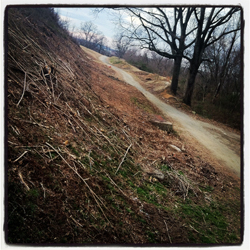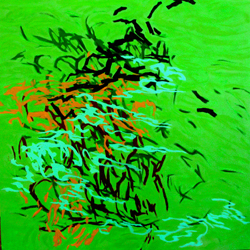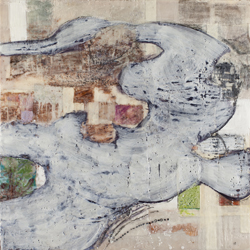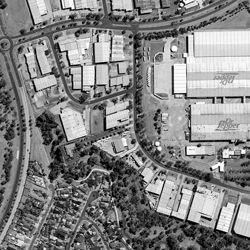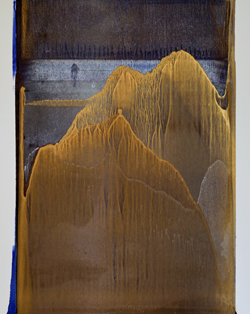Satellite Exhibition
The American Landscape
January 18 — April 29, 2013
The American Landscape, 1708 Gallery's latest satellite exhibition at Richmond's historic Linden Row Inn, features works by Terry Brown, Janis Goodman, Joe Olney, Martha Saunders, Paul Thulin and Randy Toy.
A little more than four years ago 1708 Gallery's Executive Director was approached regarding the possibility of presenting contemporary art exhibitions for the historic Linden Row Inn. As Obama's inaugural was on the horizon and the Inn had been booked solid for months we decided to give it a trial run. Our first exhibition was titled Drawing from History and included Richmond artists whose work riffed on art and American history. Four years later, with another inaugural on the horizon we present to you The American Landscape.
This exhibition has similar aspirations as it brings together a collection of artists from the Mid Atlantic region whose work is inspired by both the political and the physical turf of America. There is presence in the paintings, prints and photography you'll see here - and often prescience - that wavers between concern and optimism for our country and our planet - this place we call home.
Amie Oliver
1708 Gallery Satellite Exhibitions Liason and Curator
Participating Artists
Terry Brown
This is just the stuff along the way. It's photographs made between here and there. Looking, always looking for that something somewhere.
Janis Goodman
Janis Goodman's work moves between the narrative and the deconstructed. It is based on the laws of nature but governed by intuition and experience. Years of hiking national parks and kayaking rivers along the mid Atlantic and New England have formed the backdrop of her work. Her fascination with natural disasters additionally fuels the sense of the absurd and the possibility of chance.
Ms. Goodman's oil paintings travel and negotiate the ripples and tides of estuaries and coves. They also follow the invisible energy paths connecting the dots between the observed, imagined and remembered. Her Exploding color forcefully expands out in all directions suggesting chaos, impermanence and random activity.
Ms. Goodman's paintings don't specifically pay witness to an event but set up a strategy of cause and effect. They slow down the motion that is invisible to the eye and give the observer visual signs of a time or a direction. There are sufficient clues in the work to give the impression of an attempt to shadow nature; this quickly dissipates, as one is made aware of the transience of the subject.
Joe Olney
For the past two years, I've been making work that pulls from my wartime experiences in northern Iraq. In my paintings, sculptures, and installations I create images and objects that are visually quiet that subtly hint at tragedies and atrocities that I either witnessed or took part in while overseas. A recurring subject in my work is the limbo of sorts that separates the combat zone from home. Through my artwork, it's my aim to shed light on the disconnection and isolation that result from the feeling of being "neither here nor there." My palette consists of muted tones that provide a tension of opposites in the context of wartime imagery. The use of this sort of camouflage hopefully provides an initial sweetness that ultimately turns bitter as the viewer spends time with the work.
Another focus of my work deals with formal abstraction. These drawings and paintings provide me with a more direct call-and-response way of working the image where materials such as paint, graphite, duct tape, an plywood are laid down and then partially erased or sanded into. Within these layered works, I build spontaneous compositions that allow the pentimenti to peak through and act as the remnants or "scars" of previous decisions. Although these works are not directly related to combat experiences, they do address the past in their making which, for me, serves as a metaphor for conflicts that I have with my own past and current disposition.
Martha Saunders
My recent work fuses materials, information and inspiration from neurological maps, Japanese scrolls, and observational drawing. The intention is to create an assemblage, where transitions between imagery, raw materials, and notations push the painting to function as a phenomenon.
Paul Thulin
This series examines micro and macro topographies co-opted by the intrusive and spectacle quality of modern day advertising. Contemporary advertising practices and theories essentially value the landscape as a textual commodity rather than precious natural resource. This sensibility has fully contaminated our environment with capitalist slogans, borderless commercialization, and designed consumer waste. As an environmentalist and ethically driven image-maker, my goal is to aid individuals in becoming critically aware of the threatening corporate vision interrupting our experience and preservation of nature.
Place Your Ad Everywhere consists of digitally enhanced screen captures of Google Earth satellite imagery of actual large scale corporate advertisements juxtaposed with personal photographs of street litter product packaging documented during afternoon walks. The work is printed as 20'x20' Archival matte inkjet prints.
Randy Toy
The Zhin Tu Monoscape Series was inspired by the wonder and mystery of an unexpected discovery. The work (and the process that made it) grew out of the recognition and validation of what was an unconscious drawing method. Vistas of rolling hills, mountains, clouds, rainstorms and reflective rivers suggested themselves from the residue of fluid ink that has been squished, bled and dragged along the paper's surface. The imagery of the sixty works in the series conjure photographs of the rugged and varied terrain of the Yellow Mountains while the marks themselves reference art history and bear a striking resemblance to traditional Chinese landscape painting. The visual ties are readily established; however the ink bleeds also hold a curious and uncanny conceptual tie to a brushmaster's striving for unburdened, empty mark making. The studio is a place of mystery that has the power to weave what appear to be unconnected, disparate elements into something that is profoundly logical, beautiful and tied into the continuum more completely than I could have imagined.
